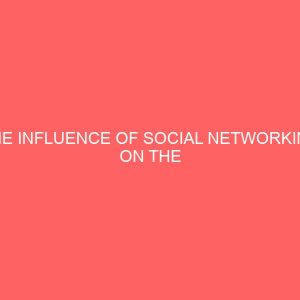Description
CHAPTER ONE
INTRODUCTION
1.1 Background of the Study
The internet plays a fundamental role in organizations and societies. The basic fact justifies the information revolution that has been taking place across the globe in recent times. The term internet, according to Cawkell in Ogedegbe 2006, p.152 is a large computer network formed out of some thousands of interconnected networks, and it supports a whole range of services such as electronic, file transfer protocol, data base access and many others. It is therefore not surprising the success story behind the advent of the internet. It is also known as a network that links computers all over the world by satellite and telephone, connecting users with service networks such as Email and the world wide web. Today the internet has linked thousands of nations and enterprises across the world. Hence the world which appears physically large has been made small by the internet and justifies the reference to the world as a global village.
The internet gave rise to the birth of social networking sites, which, according to Okenwa 2008, p. 15 are webbased services that allow individuals to 1 construct a public or semipublic profile within a bounded system, 2 articulate a list of other users with whom they share a connection, and 3 view and traverse their list of connections and those made by others within the system. What makes social network sites unique is not that they allow individuals to meet strangers, but rather that they enable users to articulate and make visible their social networks. This can result in connections between individuals that would not otherwise be made, but that is often not the goal, and these meetings are frequently between existing ties who share some offline connection Hawthorn, 2005. On many of the large social networking sites, participants are not necessarily networking or looking to meet new people; instead, they are primarily communicating with people who are already a part of their extended social network.
Social networking began in 1978 with the Bulletin Board System or BBS. The BBS was hosted on personal computers, requiring that users dial in through the modem of the host computer, exchanging information over phone lines with other users. This was the first system that allowed users to sign in and interact with each other; it was quite slow since only one user could be logged in at a time. Later in the year, the very first copies of web browsers were distributed using the bulletin board, Usenet. Usenet was created by Jim Ellis and Tom Truscott, and it allowed users to post news articles or posts, which were referred to as news. The difference between Usenet and other BBS and forums was that it didnt have a dedicated administrator or central server. There are modern forums that use the same idea as Usenet today, including Yahoo Groups and Google Groups.
The first version of instant messaging came about in 1988 with Internet Relay Chat IRC. IRC was Unixbased, limiting access for most people. It was used for link and file sharing, and generally keeping in touch with one another. Geocities was among the first social networking sites on the internet, launching its website in 1994. Its intent was to allow users to create their own websites, dividing them into groups based on the websites content. In 1995, TheGlobe.com was launched, offering users the ability to interact with people who held the same interests and publish their own content. Two years later, in 1997, AOL Instant Messenger and SixDegrees.com were launched. This was the year instant messaging became popular and it was the first time internet users were able to create a profile and befriend each other.
Friendster, created in 2002 was the pioneer of social networking. In its first three months, the social networking website acquired 3 million users, amounting to 1 in 126 internet users being members at the time. Friendster served as the launching point for the widely popular MySpace, which cloned Friendster and launched after just 10 days of coding. In the following years, other social networking websites like Classmates.com, LinkedIn and Tribe.net started to come up, including what was to be the most popular social networking website in internet history, Facebook.com was launched in 2004 with the intent to connect U.S. college students, starting with Harvard College. In its first month, over half of the 19,500 students signed up. After gaining popularity, Facebook opened its registration to noncollege students, and in 2008, Facebook surpassed MySpace as the leading social networking website. Social networking has come a long way since 1978, and we will all witness its evolution for years to come, forever changing the way people connect with one another.
While social network sites have implemented a wide variety of technical features, their backbone consists of visible profiles that display an articulated list of Friends who are also users of the system. Profiles are unique pages where one can type oneself into being Sunder 2003, p. 3. After joining a social network site, an individual is asked to fill out forms containing a series of questions. The profile is generated using the answers to these questions, which typically include descriptors such as age, location, interests, and an about me section. Most sites also encourage users to upload a profile photo. Some sites allow users to enhance their profiles by adding multimedia content or modifying their profiles look and feel. Others, such as Facebook, allow users to add modules Applications that enhance their profile.
After joining a social network site, users are asked to identify others in the system with which they have a relationship. Most social network sites require bidirectional confirmation for Friendship, but some do not. These one-directional ties are sometimes labelled as Fans or Followers, but many sites call these Friends as well. The term Friends can be misleading, because the connection does not necessarily mean friendship in the everyday vernacular sense, and the reasons people connect are varied Boyd, 2006.
These sites also provide a mechanism for users to leave messages on their Friends profiles. This feature typically involves leaving comments, although sites employ various labels for this feature. In addition, social networks often have a private messaging feature similar to webmail. While both private messages and comments are popular on most of the major networking sites, they are not universally available.
Beyond profiles, Friends, comments, and private messaging, network sites vary greatly in their features and user base. Some have photosharing or videosharing capabilities; others have builtin blogging and instant messaging technology. There are mobilespecific social network sites e.g., Dodgeball, but some webbased sites also support limited mobile interactions e.g., Facebook, MySpace, and Cyworld. Many networking sites target people from specific geographical regions or linguistic groups, although this does not always determine the sites consistency. Orkut, for example, was launched in the United States with an Englishonly interface, but Portuguesespeaking Brazilians quickly became the dominant user group Kopytoff, 2004. Some sites are designed with specific ethnic, religious, sexual orientation, political, or other identitydriven categories in mind. There are even sites for dogs Dogster and cats Catster, although their owners must manage their profiles. This then brings to mind the fact that everyone needs to interact both humans and animals alike.
1.2 Statement of the Problem
The introduction of information technology in Nigeria is a welcome development. The use of internet for educational purposes is also of immense benefit especially in the area of being globally relevant and current. However, when it becomes a substitute for good means of social interactions and academic study among young people, it should give cause for concern.
Students nowadays spend the better part of their time in school on information technology devices such as palmtops, iPods and blackberry. On close enquiry, one usually finds out that they are social networking with friends and rarely getting information on their various school courses. Often times, information sought is subject to the use of technological media especially for pleasure, to while away time and to interrelate with friends and pals on Facebook, twitter etc.. The question this research seeks to answer is; how has social networking influenced students with regards to their academic performance
1.3 Objectives of the Study
1. To determine the influence of social networking on the academic performance of Caritas University Students.
2. To ascertain the amount of time students spend on social networking sites.
3. To determine the impact of social networking on the grade points of students of Caritas University.
1.4 Research Questions.
1. How has social networking influenced the academic performance of Caritas University students
2. How much time do students of Caritas University spend on social networking sites
3. How has social networking impacted on the grade points of Caritas University students
1.5 Scope of the Study
A particular focus is given to the academic behaviour of emerging university students. An overview was provided of the recent transformation of institutions into providers of information Centres. This also seems to have taken a negative impact on reading habits and social interaction as they would rather listen to people talk on YouTube and chat with friends on Facebook, Twitter e.t.c. so they do not feel the need to read any longer. The study is centred on the students of Caritas University. This research seeks to show how social networking influences the academic performance of Caritas University students.
1.6 Significance of the Study
This study will help students to discover how much social networking influences their academic performance; it will also enlighten academic personnel on both the good and bad aspects of social networking to ensure academic growth for their students. The study will benefit students in their usage of these networking sites and also institutions to create a more conducive environment for learning.
1.7 Operational Definition of Terms
Internet is a collection of computers and computer networks located all over the world, all of which share information by agreed upon protocols.
Social Networking Service this is an online site that focuses on facilitating the building of social networks or social relations among people who share activities, interests, background thus allowing them share ideas, events among themselves.
Academic Performance refers to how students deal with their studies and how they cope with or accomplish different tasks given to them by their teachers.
Student a person who studies at a school, college or university.








Reviews
There are no reviews yet.